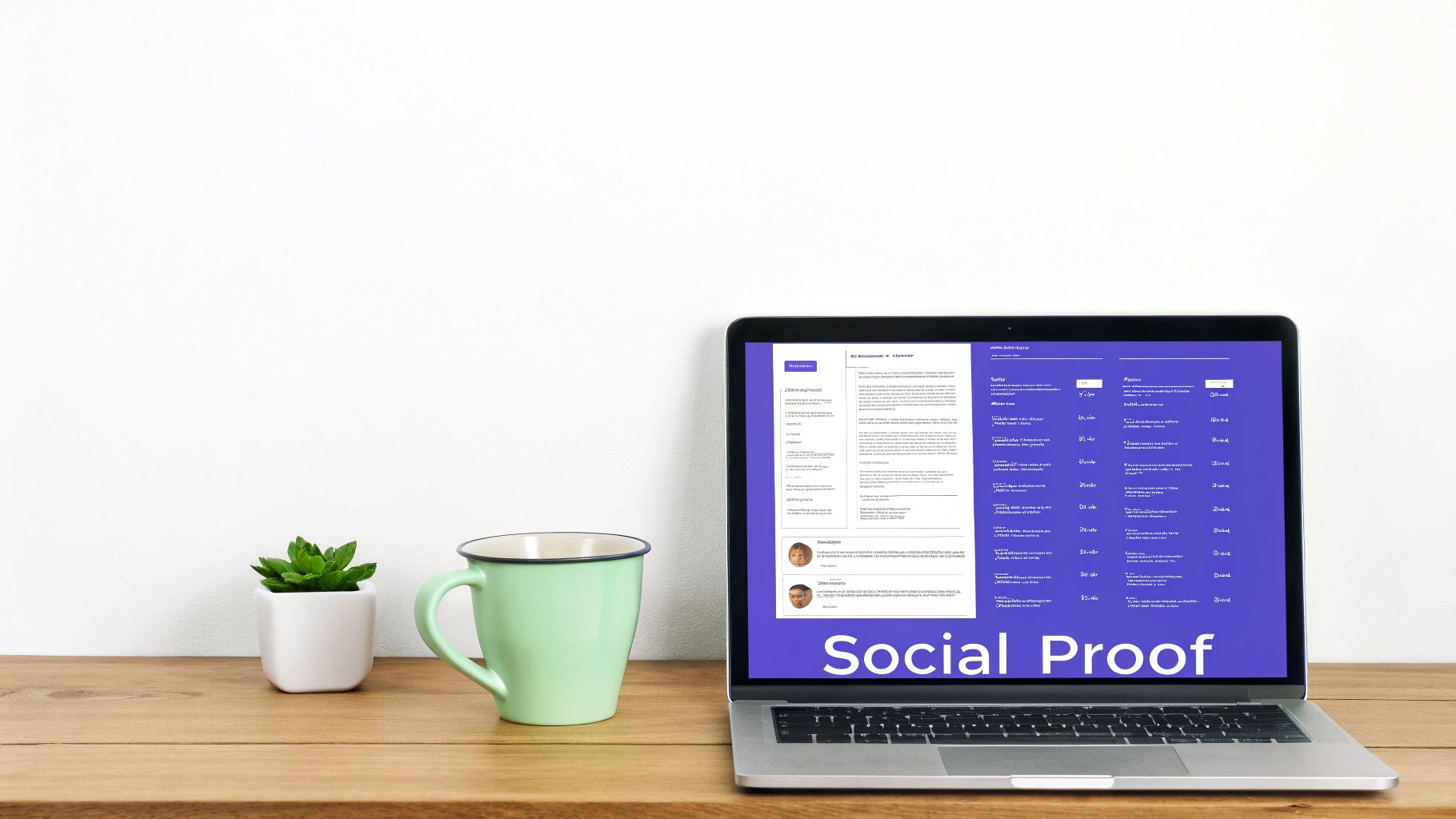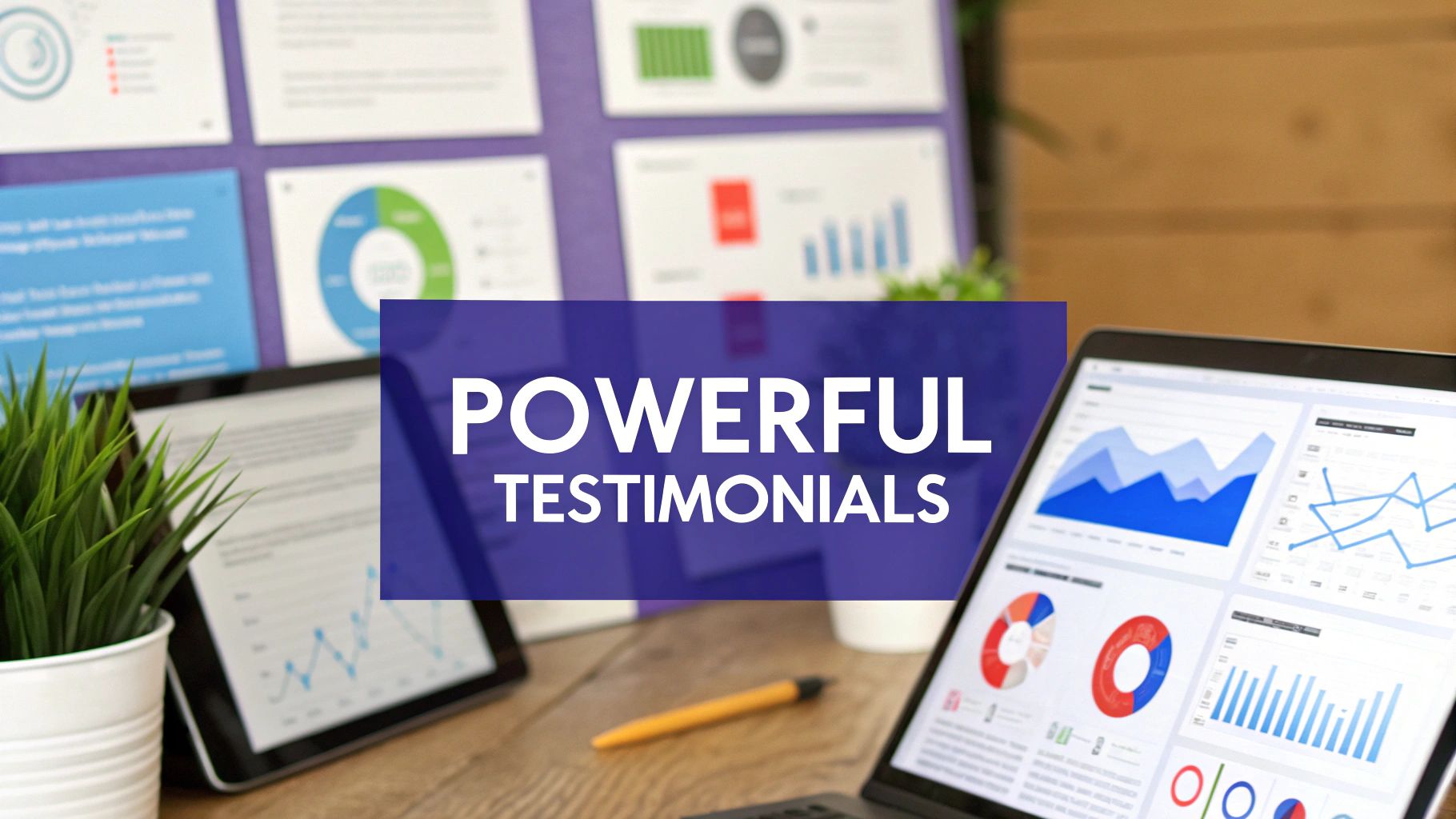How to Write a Testimonial That Sells
Struggling with how do you write a testimonial that builds trust? Get actionable advice and real-world examples to craft customer stories that convert.

A great testimonial tells a story. It needs to walk a potential customer through a specific, authentic journey. It should start with the problem they faced, show how your product was the solution, and end with the measurable results they saw.
Why Effective Testimonials Are Your Best Sales Tool

Before we get into how to write one, let's talk about why a good testimonial works so well. A powerful customer story is more than a nice quote for your homepage. It is a direct line to building trust with people who are on the fence about buying.
Think of it as word-of-mouth for the digital age. When prospects see that other companies, just like them, have solved the exact same problems with your software, it provides immediate social proof. This is a big deal, particularly in a crowded SaaS market where everyone is looking for validation before they pull out their credit card.
Building Trust and Shortening Sales Cycles
A well-written testimonial cuts through the noise and answers the questions every potential customer is silently asking: "Will this actually work for my business?" and "Can I really trust this company?" By showing real-world success, you handle those objections before they even have a chance to come up.
This stuff has a real impact on buying decisions. A large number of customers, 72% in fact, say they trust a business more after reading positive testimonials. Done right, these authentic stories can boost sales by as much as 270% by turning lukewarm interest into a signed deal. It's one of the most effective ways to improve website conversion rates.
A testimonial is a short story that walks a potential customer from a familiar problem to a desirable solution, making your product the clear hero of the journey.
This kind of authentic validation naturally shortens the sales cycle. Prospects show up to a demo or a sales call already informed, confident, and ready for a serious conversation with your team.
The Anatomy of a High-Converting Testimonial

Ever wonder what separates a forgettable review from a testimonial that actually gets people to click "buy"? It's not just luck. The best ones tell a compelling story.
It’s all about showing a clear transformation. You want to take a potential customer from a problem they know all too well to a result they want.
Every great testimonial has three core parts: the before, the during, and the after.
- The Before: This sets the stage. It’s where you detail the specific challenge or pain point the customer was dealing with. This is your chance to connect with prospects by showing you get their struggles.
- The During: This part is straightforward. It’s where the customer describes what it was like to start using your product.
- The After: Here’s where the magic happens. This is where you spotlight the specific, measurable results they achieved.
This simple framework transforms a generic quote into a believable story of success.
Focus on Concrete Results
Vague praise just doesn't cut it. A customer saying your tool "was really helpful" is nice, but it won’t move the needle.
Now, compare that to a testimonial that states it "cut our project time by 30%." See the difference? Numbers and specific outcomes build instant credibility and make the benefits feel real and achievable.
You're telling a story, and every good story needs tangible details. To make this process easier, you can use a template for a testimonial from a customer to guide the conversation and make sure you capture these key elements.
"Our team was spending 10 hours a week manually tracking feedback. After implementing the new software, we automated the entire process, saving us a full day of work each week and increasing our response rate by 50%."
Notice how that example clearly outlines the problem (10 hours wasted), the solution (automating the process), and the impressive result (a 50% increase). That’s the kind of detail that turns a reader into a lead.
To help you structure your own testimonials, here’s a quick breakdown of the necessary components.
Key Elements of an Effective Testimonial
By making sure your testimonials hit these key points, you create a powerful narrative that resonates with potential customers.
Of course, a great testimonial is only half the battle. You also need to know where to place it. Looking at broader proven strategies to improve website conversion rate will help you position these powerful statements for maximum impact on your site.
How to Capture an Authentic Voice and Tone
The best testimonials feel real because they are. They sound like they came from an actual customer, not your marketing department. Capturing that authentic voice is all about focusing on genuine experiences instead of polished corporate jargon.
An overly perfect, exaggerated review can actually make potential customers suspicious. People are more skeptical than ever these days. With the explosion of fake reviews, 62% of consumers are concerned about authenticity, which means an honest tone isn't just nice to have. It's a must. You can see more on this trend and other review statistics on shapo.io.
This is exactly why you should always aim for a conversational style that connects with readers on a personal level.
Keep It Natural and Relatable
The first step is to avoid editing the personality right out of the customer's feedback. If what they sent over is a bit quirky or uses everyday language, leave it in. It's those little imperfections that make a testimonial believable.
Think about how people actually talk. They use contractions, simple sentences, and show real emotion. Don't smooth it all out.
- Ditch the corporate-speak: Forget words like "synergy," "optimize," or "leverage." Just use simple, direct language.
- Ask for a story: Encourage customers to describe their experience from beginning to end. Storytelling naturally brings out a person's unique voice.
- Let the emotion shine: A comment like, "Honestly, this saved us so much frustration," is way more powerful than a generic compliment.
Getting this kind of raw material all starts with how you gather the feedback in the first place. For some practical tips, check out our guide on how to ask for testimonials in a way that encourages authenticity.
A customer’s real words will always be more persuasive than a perfectly crafted marketing message. Your job is to guide their story, not rewrite it.
Balance Positivity with Credibility
Of course, you want your testimonials to be positive, but they also need to be credible. A story that only highlights flawless success can sometimes feel a little too good to be true.
If a customer happens to mention a small, initial hesitation or a specific challenge they overcame using your product, including it can actually make the testimonial stronger. It adds a layer of honesty and shows a realistic journey.
For example, a customer saying, "I was skeptical at first, but the results were undeniable," builds far more trust than a simple, glowing review.
Turning Testimonials into Powerful Marketing Assets

A fantastic customer testimonial is so much more than a block of text you drop on your pricing page. When you get a really good one, think of it as a goldmine of marketing content that can be used across tons of different channels.
The trick is to stop seeing testimonials as a single, static story. Instead, look at each one as a collection of powerful, bite-sized messages. This mindset shift is what allows you to squeeze every last drop of value out of each customer success story.
Create a Headline That Grabs Attention
Every killer testimonial needs a headline that pops. This is a super-short summary of the absolute best result the customer got. It's the very first thing a prospect will read, so it has to hook them immediately.
A great headline is all about the outcome. For example, instead of a boring title like "A Testimonial from Company X," you want to hit them with something like, "How Company X Reduced Churn by 25% in 60 Days." Right away, that tells a compelling story and shines a spotlight on a specific, juicy result.
The most effective headlines combine the customer's name with their single biggest win. This simple formula builds instant credibility and draws the reader into the story.
By leading with a benefit-driven headline, you make the testimonial instantly scannable and way more impactful.
Break It Down for Maximum Impact
Once you have the full customer story, it's time to start pulling out the best parts. Look for short, punchy quotes that are perfect for social media posts, ad copy, or as callouts on your website. Zero in on sentences that are packed with emotion or a powerful statistic.
You can then sprinkle these short quotes strategically across your website to add credibility exactly where it's needed. Got a quote about how easy your product is to use? That's perfect for a features page. Our guide on using testimonials on a website has even more ideas for smart placement.
Customizing these snippets makes the content feel more personal and relevant. And it works. A large number of consumers, 82% to be exact, feel better about a brand after reading customized content. You can dig into more stats like this in these insights on content marketing trends from omnius.so.
Real-World Examples of Testimonials That Convert
Theory is great, but seeing how it all works in the real world is where things really start to click. So, let’s break down a few powerful testimonials to show you exactly what makes them so effective.
We'll look at how specific details, storytelling, and tackling objections head-on can transform a simple quote into a serious conversion driver. Each one highlights the principles we’ve talked about, giving you a clear picture of what a high-converting testimonial actually looks like out in the wild.
The Data-Driven SaaS Testimonial
This example from a project management tool gets straight to the point by proving ROI with cold, hard numbers. It’s direct, credible, and speaks directly to results-oriented managers who need to justify every purchase.
"Before using this tool, our team was losing about 10 hours per week to administrative tasks and manual follow-ups. Within the first month, we cut that time in half. Now, we're consistently saving those 10 hours and have seen a 25% increase in on-time project delivery."
- Jane Doe, Project Manager at Innovate Corp
So, why does this one work so well?
- A Tangible Pain Point: "Losing about 10 hours per week" is a problem anyone in management can instantly relate to.
- Hard Metrics: It provides two concrete numbers: hours saved and a 25% boost in project delivery. No fluff.
- Speed to Value: Highlighting success "within the first month" shows prospects they won’t have to wait forever to see a return.
This kind of testimonial is gold for SaaS companies because it draws a straight line from the product to measurable business outcomes.
The Story-Driven Service Testimonial
Sometimes, the most powerful testimonials aren’t about numbers at all. They tell a compelling story that forges an emotional connection with your audience. This approach is perfect for services where the personal transformation is the real selling point.
Imagine a business coaching service featuring a testimonial from a founder who was completely overwhelmed and on the brink of burnout.
The story could walk a prospect through the founder's initial struggles, the game-changing advice they received, and how it helped them finally regain control and rediscover their passion. It’s less about a single metric and more about the entire journey. This narrative style helps potential clients see themselves in the story, making the service feel more personal and deeply impactful. By leaning into the human element, the testimonial becomes far more memorable than a simple stat ever could.
Of course, even with a solid framework in place, there are always those nagging little questions about the details. Getting these final points right can be the difference between a customer story that resonates and one that falls flat.
Let's clear up some of the most common questions that pop up.
How Long Should a Testimonial Be?
You'll want to aim for the sweet spot: somewhere between 50 and 150 words.
That's enough real estate to tell a mini-story with specific details, but it’s still short enough for a busy prospect to scan in a few seconds.
For punchier placements like website callouts or social media posts, a single powerful sentence or two can work wonders. And if you're building out a full case study, feel free to let the story breathe and run much longer.
What Is the Best Format for a Testimonial?
The most compelling testimonials almost always follow a simple narrative arc: Problem-Solution-Result. It’s a classic for a reason. It is easy for readers to follow and makes your product’s value crystal clear.
Here’s how it breaks down:
- Start with their pain point: What specific challenge was the customer wrestling with before they found you?
- Introduce your product as the hero: How did your solution step in and help them tackle that problem?
- End with the win: What specific, positive outcomes did they achieve? Don't be shy with numbers here!
Adding the customer's name, company, and a high-quality photo gives the story a face. It instantly adds a massive layer of credibility and makes the testimonial feel much more human and trustworthy.
Do I Need Permission to Use a Testimonial?
Yes, 100%. This is non-negotiable.
You absolutely must get clear, written permission from your customer before using their words, name, or image in any of your marketing materials. It’s a matter of respect.
A good practice is to also send them the final, edited version for a quick approval before it goes live. This little step shows you value their partnership and helps keep that customer relationship strong.
Ready to turn happy customers into your most powerful marketing asset? Surva.ai gives your SaaS team the tools to gather authentic testimonials, predict and reduce churn, and truly know what your users need. See how Surva.ai can help you grow.


